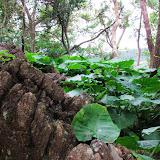 |
| Ruins of an Old 329 |
View Map It! Okinawa in a larger map
 |
| Modern Day Ruins of an Old 329 |
GPS
| Latitude | Longitude |
| N 26 34.240 | E 127 59.707 |
Modern Day Ruins of an Old 329
Ruins are abundant here on Okinawa, both from the Okinawan War and from the old Ryukyu Kingdom. But ruins don't become ruins over night. There is a natural cycle that slowly erodes and tears away at the structures that were once sought and used by men. History Channel had created a television series called 'Life After People' where they used computer simulated models to expedite the aftermath of a town or city if people were to suddenly disappear. But seeing the actual process unfold in modern times is an interesting spectacle to witness - take for example, Highway 329 going into Nago City. You may not have realized it when you were driving, but there is about a 1 km stretch that is elevated on a bridge just before the 329 hits Highway 58.
And down below you can almost say it is a world all unto itself...an underworld of sorts of over growing vegetation, streaming water, and signs of a deteriorating old road. This underworld is part of the Old 329 that once zigged-zagged down the Nago landscape going into Nago City. It is a very eerie place to wander around as you hear cars zip by above and yet, no sign of animated life down below. And yet it is a strange, but intriguing thing to see – a structure once used by men, now left at the mercy of a relentless forest slowly closing in.
It's not certain why this road was replaced by the now standing bridge.
See more pictures of the Old 329.
Parking. Recommend you park at the location of the balloon icon and start from there. There is small area where you can park your car. I don't recommend you park at the top 1km away where the bridge starts. Getting out of there can be a safety hazard. Cars going north tend to travel at high speeds around the corner.









